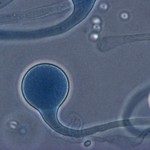Lien vers Pubmed [PMID] – 26706615
Lien DOI – S1198-743X(15)01032-010.1016/j.cmi.2015.12.006
Clin. Microbiol. Infect. 2016 Sep; 22(9): 810.e1-810.e8
The main objective of this study was to assess the diagnostic performance of a set of three Mucorales quantitative PCR assays in a retrospective multicentre study. Mucormycosis cases were recorded thanks to the French prospective surveillance programme (RESSIF network). The day of sampling of the first histological or mycological positive specimen was defined as day 0 (D0). Detection of circulating DNA was performed on frozen serum samples collected from D-30 to D30, using quantitative PCR assays targeting Rhizomucor, Lichtheimia, Mucor/Rhizopus. Forty-four patients diagnosed with probable (n = 19) or proven (n = 25) mucormycosis were included. Thirty-six of the 44 patients (81%) had at least one PCR-positive serum. The first PCR-positive sample was observed 9 days (range 0-28 days) before diagnosis was made using mycological criteria and at least 2 days (range 0-24 days) before imaging. The identifications provided with the quantitative PCR assays were all concordant with culture and/or PCR-based identification of the causal species. Survival rate at D84 was significantly higher for patients with an initially positive PCR that became negative after treatment initiation than for patients whose PCR remained positive (48% and 4%, respectively; p <10-6). The median time for complete negativity of PCR was 7 days (range 3-19 days) after initiation of l-AmB treatment. Despite some limitations due to the retrospective design of the study, we showed that Mucorales quantitative PCR could not only confirm the mucormycosis diagnosis when other mycological arguments were present but could also anticipate this diagnosis. Quantification of DNA loads may also be a useful adjunct to treatment monitoring.




